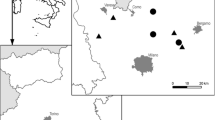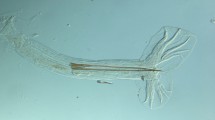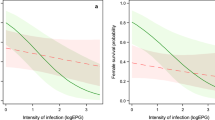Abstract
The Eurasian red squirrel (Sciurus vulgaris) is the only naturally occurring tree squirrel throughout its range. We aim at improving current knowledge on its macroparasite fauna, expecting that it will have a poor parasite diversity because in species that have no sympatric congeners parasite richness should be lower than in hosts sharing their range with several closely related species, where host-switching events and lateral transmission are promoted. We examined gastro-intestinal helminth and ectoparasite communities (excluding mites) of, respectively, 147 and 311 red squirrel roadkills collected in four biogeographic regions in Italy and France. As expected, the macroparasite fauna was poor: we found five species of nematodes and some unidentified cestodes, three fleas, two sucking lice and two hard ticks. The helminth community was dominated by a single species, the oxyurid Trypanoxyuris (Rodentoxyuris) sciuri (prevalence, 87 %; mean abundance, 373 ± 65 worms/host). Its abundance varied among seasons and biogeographic regions and increased with body mass in male hosts while decreased in females. The most prevalent ectoparasites were the flea Ceratophyllus (Monopsyllus) sciurorum (28 %), whose presence was affected by season, and the generalist tick Ixodes (Ixodes) ricinus that was found only in France (34 %). All the other helminths and arthropod species were rare, with prevalence below 10 %. However, the first record of Strongyloides robustus, a common nematode of North American Eastern grey squirrels (S. carolinensis), in two red squirrels living in areas where this alien species co-inhabits, deserves further attention, since low parasite richness could result in native red squirrels being particularly vulnerable to parasite spillover.




Similar content being viewed by others
References
Anderson RC (2000) Nematode parasites of vertebrates: their development and transmission, 2nd edn. CABI Publishing, Wallingford
Audebert F, Cassone J, Kerboeuf D, Durette-Desset M-C (2003) Development of Trichostrongylus colubriformis and Trichostrongylus vitrinus, parasites of ruminants in the rabbit and comparison with Trichostrongylus retortaeformis. Parasitol Res 90:57–63
Beaucournu J-C (1968) Les Anoploures de Lagomorphes, Rongeurs et Insectivores dans la région paléarctique occidentale et en particulier en France. Ann Parasit Hum Comp 43:201–271
Beaucournu J-C, Launay H (1990) Les puces de France et du bassin méditerranéen occidental. Faune de France 76. Fédération Française des Sociétés de Sciences Naturelles, Paris
Beaucournu J-C, Pisanu B, Chapuis J-L (2008) Enderleinellus tamiasis Fahrenholz, 1916 (Anoploura: Enderleinellidae), espèce importée, implantée et nouvelle pour la faune de France. Parasite 15:175–178
Bertolino S, Genovesi P (2005) The application of the European strategy on invasive alien species: an example with introduced squirrels. Hystrix It J Mamm 16:59–69
Bertolino S, Lurz PWW (2013) Callosciurus squirrels: worldwide introductions, ecological impacts and recommendations to prevent the establishment of new invasive populations. Mammal rev 43:22–33
Bosch S, Lurz PWW (2012) The Eurasian red squirrel. Westarp Wissenschaften, Hohenwarsleben
Brooks DR, McLennan DA (1991) Phylogeny, ecology, and behavior. A research program in comparative biology. The University of Chicago Press, Chicago
Burnham KP, Anderson DA (2004) Multi-model inference: understanding AIC and BIC in model selection. Sociol Method Res 33:261–304
Cameron TW (1932) On a new species of Oxyuris from the grey squirrel in Scotland. J Helminthol 10:29–32
Chandler AC (1942) Helminths of tree squirrels in Southeast Texas. J Parasitol 28:135–140
Chapuis JL (2005) Répartition en France d’un animal de compagnie naturalisé, le tamia de sibérie (Tamias sibiricus). Rev Ecol (Terre Vie) 60:239–253
Christe P, Morand S, Michauux J (2006) Biological conservation and parasitism. In: Morand S, Krasnov BR, Poulin R (eds) Micromammals and macroparasites. Springer, Tokyo, pp 593–613
Conti JA, Forrester DJ, Frohlich RK, Hoff GL, Bigler WJ (1984) Helminths of urban gray squirrels in Florida. J Parasitol 70:143–144
Coyner DF, Wooding JB, Forrester DJ (1996) A comparison of parasitic helminths and arthropods from two species of fox squirrels (Sciurus niger) in Florida. J Wildlife Dis 32:492–497
Cunningham AA, Daszak P, Rodriguez JP (2003) Pathogen pollution: defining a parasitological threat to biodiversity conservation. J Parasitol 89:S78–S83
Dantas-Torres F, Otranto D (2013a) Seasonal dynamics of Ixodes ricinus on ground level and higher vegetation in a preserved wooded area in southern Europe. Vet Parasitol 192:253–258
Dantas-Torres F, Otranto D (2013b) Species diversity and abundance of ticks in three habitats in southern Italy. Ticks Tick-Borne Dis 4:251–255
Daszak P, Cunningham AA, Hyatt AD (2000) Emerging infectious diseases of wildlife—threats to biodiversity and human health. Science 287:443–449
Davidson WR (1976) Endoparasites of selected populations of Gray Squirrels (Sciurus carolinensis) in the southeastern United States. Proc Helminthol Soc Wash 43:211–217
Di Pierro E, Molinari A, Tosi G, Wauters LA (2008) Exclusive core areas and intrasexual territoriality in Eurasian red squirrels (Sciurus vulgaris) revealed by incremental cluster polygon analysis. Ecol Res 23:529–542
Dunn AM (2009) Parasites and biological invasions. Adv Parasitol 68:161–184
Durden LA, Musser GG (1994) The sucking lice (Insecta, Anoplura) of the world: a taxonomic checklist with records of mammalian hosts and geographical distributions. Bull Am Mus Nat Hist 218:1–90
Durden LA, Ellis BA, Bank CW, Crowe JD, Oliver JH Jr (2004) Ectoparasites of gray squirrels in two different habitats and screening of selected ectoparasites for bartonellae. J Parasitol 90:485–489
Durette-Desset M-C (1983) Keys to genera of the Superfamily Trichostrongyloidea. In: Anderson RC, Chabaud AG (eds) CIH Keys to the nematodes parasites of vertebrates. Cambridge Agricultural Bureau, Cambridge, pp 1–86
Eckerlin RP (1974) Studies on the life-cycle of Strongyloides robustus Chandler, 1942, and a survey of the helminths of Connecticut sciurids. PhD Dissertation, University of Connecticut
Feliu C, Torres J, Miquel J, Casanova JC (1994) The helminthfaunas of rodents of the Iberian Peninsula in relation to continental rodents: the case of Sciurus vulgaris Linnaeus, 1758 (Sciuridae). Res Rev Parasitol 54:125–127
Ferrari N, Rosà R, Pugliese A, Hudson PJ (2007) The role of sex in parasite dynamics: model simulations on transmission of Heligmosomoides polygyrus in populations of yellow-necked mice, Apodemus flavicollis. Int J Parasitol 37:341–349
Ferrari N, Rosà R, Lanfranchi P, Ruckstuhl KE (2010) Effect of sexual segregation on host–parasite interaction: model simulation for abomasal parasite dynamics in alpine ibex (Capra ibex). Int J Parasitol 40:1285–1293
Flyger V, Gates JE (1982) Fox and gray squirrel, Sciurus niger, Sciurus caroliensis and allies. Pine squirrell, Tamiasciurus hudsonicus and T. douglasii. In: Chapman JA, Feldhammer GA (eds) Wild mammals of North America: biology, management, and economics. The Johns Hopkins University Press, Baltimore, pp 209–238
Gurnell J (1987) The natural history of squirrels. Helm, London
Haukisalmi V, Hanski IK (2007) Contrasting seasonal dynamics in fleas of the Siberian flying squirrel (Pteromys volans) in Finland. Ecol Entomol 32:333–337
Hudson PJ, Dobson AP, Lafferty KD (2006) Is a healthy ecosystem one that is rich in parasites? TRENDS Ecol Evol 21:381–385
Hugot JP (1984) Sur le genre Trypanoxyuris (Oxyuridae, Nematoda) I. Parasites de Sciuriés: sous-genre Rodentoxyuris. Bull Mus Natl Hist Nat 6:711–720
Hugot JP, Feliu C (1990) Description de Syphabulea mascomai n. sp. et analyse du genre Syphabulea. Syst Parasitol 17:219–230
Khalil LF, Jones A, Bray RA (1994) Keys to the cestode parasites of vertebrates. CAB International, Wallingford
Krasnov BR, Khokhlova IS, Shenbrot GI (2002) The effect of host density on ectoparasite distribution: an example of a rodent parasitized by fleas. Ecology 83:164–175
Krasnov BR, Shenbrot GI, Khokhlova IS, Degen AA (2004) Flea species richness and parameters of host body, host geography and host ‘milieu’. J Anim Ecol 73:1121–1128
Krasnov BR, Morand S, Hawlena H, Khokhlova IS, Shenbrot GI (2005) Sex-biased parasitism, seasonality and sexual size dimorphism in desert rodents. Oecologia 146:209–217
Krasnov BR, Poulin R, Morand S (2006) Patterns of macroparasite diversity in small mammals. In: Morand S, Krasnov BR, Poulin R (eds) Micromammammals and macroparasites. From evolutionary ecology to management. Springer, Tokyo, pp 197–231
Lurz PWW, Gurnell J, Magris L (2005) Sciurus vulgaris. Mammalian Species 769:1–10
Marques JF, Santos MJ, Teixeira CM, Batista MI, Cabral HN (2011) Host–parasite relationships in flatfish (Pleuronectiformes)—the relative importance of host biology, ecology and phylogeny. Parasitol 138:107–121
Martinoli A, Bertolino S, Preatoni DG, Balduzzi A, Marsan A, Genovesi P, Tosi G, Wauters LA (2010) Headcount 2010: the multiplication of the grey squirrel introduced in Italy. Hystrix It J Mamm 21:127–136
Mercer JM, Roth VL (2003) The effects of Cenozoic global change on squirrel phylogeny. Science 299:1568–1572
Parker JC (1971) Protozoan, helminth and arthropod parasites of the grey squirrel in south-western Virginia. PhD Dissertation, Virginia Polytechnic Institute
Pérez-Eid C (2007) Les tiques: identification, biologie, importance médicale et vétérinaire. Lavoisier, Paris
Pisanu B, Jerusalem C, Huchery C, Marmet J, Chapuis J-L (2007) Helminth fauna of the Siberian chipmunk, Tamias sibiricus Laxmann (Rodentia, Sciuridae) introduced in suburban French forests. Parasitol Res 100:1375–1379
Pisanu B, Marmet J, Beaucournu J-C, Chapuis J-L (2008) Diversité du cortège en Siphonaptères chez le Tamia de Sibérie (Tamias sibiricus Laxmann) introduit en forêt de Sénart (Ile-de-France). Parasite 15:35–43
Pisanu B, Lebailleux L, Chapuis J-L (2009) Why do Siberian chipmunks Tamias sibiricus (Sciuridae) introduced in French forests acquired so few intestinal helminth species from native sympatric Murids? Parasitol Res 104:709–714
Popiolek M, Hildebrand J, Zalesny J (2009) Morphology and taxonomy of Rodentoxyuris sciuri Quentin et Tenora, 1974 (Nematoda: Oxyurida: Enterobiinae) with notes on molecular phylogeny. Ann Zool 59:415–421
Poulin R (1996) Sexual inequalities in helminth infections: a cost of being male? Am Nat 147:287–295
Poulin R (1997) Species richness of parasite assemblages: evolution and patterns. Annu Rev Ecol Syst 28:341–358
Poulin R (2004) Macroecological patterns of species richness in parasite assemblages. Basic Appl Ecol 5:423–434
Poulin R, Mouillot D (2004) The relationship between specialization and local abundance: the case of helminth parasites of birds. Oecologia 140:372–378
Prenter J, MacNeil C, Dick JTA, Dunn AM (2004) Roles of parasites in animal invasions. TRENDS Ecol Evol 19:385–389
Raibaut A, Combes C, Benoit F (1998) Analysis of the parasitic copepod species richness among Mediterranean fish. J Mar Syst 15:185–206
Rausch R, Tiner JD (1948) Studies on the parasitic helminths of the North Central States. I. Helminths of Sciuridae. Am Midl Nat 39:728–747
Romeo C, Wauters LA, Preatoni D, Tosi G, Martinoli A (2010) Living on the edge: space use of Eurasian red squirrels in marginal high-elevation habitat. Acta Oecol 36:604–610
Rushton SP, Lurz PWW, Gurnell J, Nettleton P, Bruemmer C, Shirley MDF, Sainsbury AW (2006) Disease threats posed by alien species: the role of a poxvirus in the decline of the native red squirrel in Britain. Epid Infect 134:521–533
Sato H, Torii H, Une Y, Ooi H-K (2007) A new Rhabditoid nematode species in Asian sciurids, distinct from Strongyloides robustus in North American Sciurids. J Parasitol 93:1476–1486
Schalk G, Forbes MR (1997) Male biases in parasitism of mammals: effects of study type, host age and parasite taxon. Oikos 78:67–74
Shaw DJ, Grenfell BT, Dobson AP (1998) Patterns of macroparasite aggregation in wildlife host populations. Parasitology 117:597–610
Shimalov VV, Shimalov VT (2002) Helminth fauna of the red squirrel (Sciurus vulgaris Linnaeus, 1758) in Belorussian Polesie. Parasitol Res 88:1008
Smit FGAM (1957) Handbook for the Identification of British Insects, 1. Royal Entomological Society, London
Steele MA, Koprowski JL (2001) North American tree squirrels. Smithsonian Institution, Washington
Tompkins DM, Poulin R (2006) Parasites and biological invasions. In: Aleen RB, Lee WG (eds) Biological Invasions in New Zealand. Springer, Berlin, pp 67–82
Tompkins DM, Sainsbury AW, Nettleton P, Buxton J, Gurnell J (2002) Parapoxvirus causes a deleterious diseases in red squirrels associated with UK population declines. Proc Roy Soc B 269:529–533
Traub R, Rothschild M, Haddow JF (1983) The Rothschild collection of fleas. The Ceratophyllidae: key to the genera and host relationships. With notes on their evolution, zoogeography and medical importance. Academic, Orlando
Trilar T, Radulovic S, Walker DH (1994) Identification of anatural cycle involving Rickettsia typhi infection of Monopsyllus sciurorum sciurorum fleas from the nests of the fat dormouse (Glis glis). Eur J Epidemiol 10:757–62
Verbeylen G, Wauters LA, De Bruyn L, Matthysen E (2009) Woodland fragmentation affects space use of Eurasian red squirrels. Acta Oecol 35:94–103
Wauters LA (2000) Squirrels—medium-sized Granivores in Woodland Habitats. In: Halle S, Stenseth NC (eds) Activity patterns in small mammals: a comparative ecological approach. ecological Studies 141, Springer, Heidelberg, pp 131–143
Wauters LA, Dhondt AA (1987) Activity budget and foraging behaviour of the red squirrel (Sciurus vulgaris, Linnaeus, 1758) in a coniferous habitat. Mamm Biol 52:341–352
Wauters LA, Dhondt AA (1989) Body weight, longevity and reproductive success in red squirrels (Sciurus vulgaris). J Anim Ecol 58:637–651
Wauters LA, Dhondt AA (1990) Nest-use by red squirrels (Sciurus vulgaris Linnaeus, 1758). Mammalia 54:377–389
Wauters LA, De Vos R, Dhondt AA (1990) Factors affecting male mating success in red squirrels (Sciurus vulgaris). Ethol Ecol Evol 2:195–204
Wauters LA, Bijnens L, Dhondt AA (1993) Body mass at weaning and juvenile recruitment in the red squirrel. J Anim Ecol 62:280–286
Wauters LA, Matthysen E, Adriaensen F, Tosi G (2004) Within sex-density dependence and population dynamics of red squirrels Sciurus vulgaris. J Anim Ecol 73:11–25
Wauters LA, Vermeulen M, Van Dongen S, Bertolino S, Molinari A, Tosi G, Matthysen E (2007) Effects of spatio-temporal variation in food supply on red squirrel Sciurus vulgaris body size and body mass and its consequences for some fitness components. Ecography 30:51–65
Wauters LA, Githiru M, Bertolino S, Molinari A, Tosi G, Lens L (2008) Demography of alpine red squirrel populations in relation to fluctuations in seed crop size. Ecography 31:104–114
Westrom D, Yescott R (1975) Emigration of ectoparasites from dead California ground squirrels Spermophilus beecheyi (Richardson). California Vector News: 97–103
Zuur AF, Ieno EN, Elphick CS (2010) A protocol for data exploration to avoid common statistical problems. Meth Ecol Evol 1:3–14
Acknowledgments
We would like to thank The French Ministry of Ecology (MEDDE), and the French National Forestry Office (ONF) for funding. Field collection could not have been possible without the help of the LIFE09 NAT/IT/00095 EC-SQUARE, ONF French Mammal Network, Trento and Sondrio Provinces, Stelvio National Park, Piedmont Regional Parks, Carmagnola Museum and the various people who have collected squirrels, with special thanks to Sandro Bertolino and Gwenaël Landais. Many thanks to Anne Dozières, Christie Le Coeur, Carole Lapèyre, Leila Luise, Charlotte Récapet, Francesca Santicchia and Sara Vedovato for their kind assistance in laboratory analyses. Many thanks to Jean-Claude Beaucournu who initiated the identification of fleas at an early stage of this study and to Damiano Preatoni who produced Fig. 1.
Author information
Authors and Affiliations
Corresponding author
Electronic supplementary material
Below is the link to the electronic supplementary material.
ESM 1
(DOC 1361 kb)
Rights and permissions
About this article
Cite this article
Romeo, C., Pisanu, B., Ferrari, N. et al. Macroparasite community of the Eurasian red squirrel (Sciurus vulgaris): poor species richness and diversity. Parasitol Res 112, 3527–3536 (2013). https://doi.org/10.1007/s00436-013-3535-8
Received:
Accepted:
Published:
Issue Date:
DOI: https://doi.org/10.1007/s00436-013-3535-8




